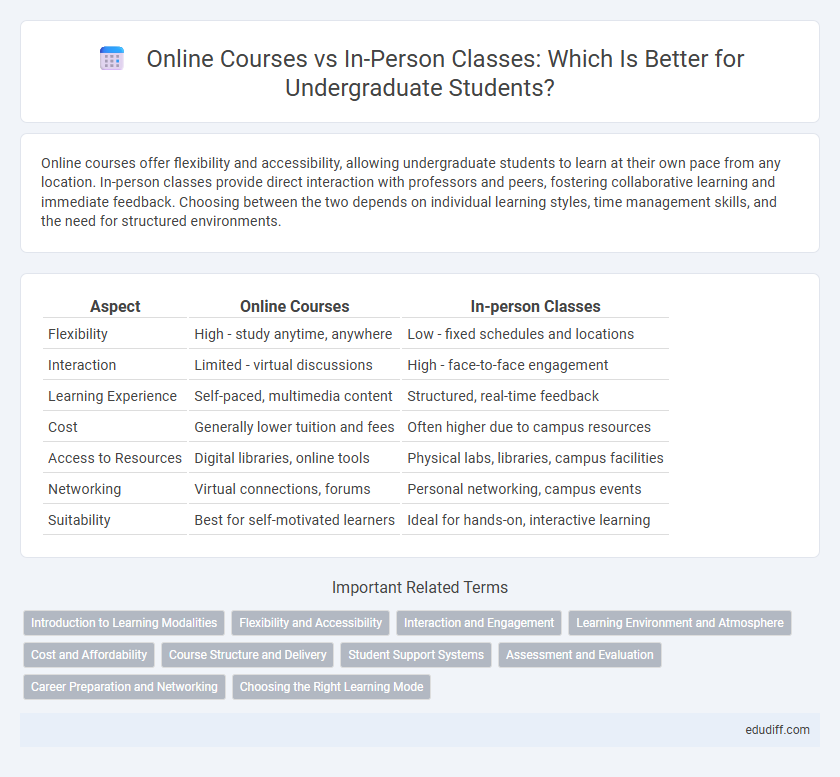Online courses offer flexibility and accessibility, allowing undergraduate students to learn at their own pace from any location. In-person classes provide direct interaction with professors and peers, fostering collaborative learning and immediate feedback. Choosing between the two depends on individual learning styles, time management skills, and the need for structured environments.
Table of Comparison
| Aspect | Online Courses | In-person Classes |
|---|---|---|
| Flexibility | High - study anytime, anywhere | Low - fixed schedules and locations |
| Interaction | Limited - virtual discussions | High - face-to-face engagement |
| Learning Experience | Self-paced, multimedia content | Structured, real-time feedback |
| Cost | Generally lower tuition and fees | Often higher due to campus resources |
| Access to Resources | Digital libraries, online tools | Physical labs, libraries, campus facilities |
| Networking | Virtual connections, forums | Personal networking, campus events |
| Suitability | Best for self-motivated learners | Ideal for hands-on, interactive learning |
Introduction to Learning Modalities
Online courses offer flexible scheduling and access to diverse resources, allowing undergraduate students to learn at their own pace. In-person classes provide direct interaction with instructors and peers, fostering collaborative learning environments critical for developing communication skills and immediate feedback. Understanding these learning modalities helps students choose formats that align with their academic goals and personal learning preferences.
Flexibility and Accessibility
Online courses offer unparalleled flexibility, allowing undergraduate students to access lectures and assignments anytime, which is ideal for balancing academics with work or personal commitments. In-person classes provide structured schedules and immediate face-to-face interaction, beneficial for students needing direct support and real-time feedback. Accessibility improves with online platforms removing geographical and physical barriers, expanding education opportunities for diverse student populations.
Interaction and Engagement
Online courses offer flexible learning environments but often lack the spontaneous interaction and immediate feedback found in in-person classes, which foster deeper student engagement through face-to-face communication. In-person classes encourage collaborative activities, group discussions, and real-time problem-solving, enhancing peer-to-peer and instructor-student relationships critical for active learning. Studies show that higher levels of engagement in physical classrooms correlate with improved comprehension, motivation, and academic performance compared to virtual settings.
Learning Environment and Atmosphere
Online courses offer a flexible learning environment with access to diverse digital resources, enabling students to study at their own pace and revisit materials as needed. In-person classes provide a dynamic atmosphere that fosters direct interaction, immediate feedback, and collaborative group activities, which can enhance understanding and retention. The choice between online and in-person learning environments significantly impacts student engagement, motivation, and overall academic performance.
Cost and Affordability
Online courses typically offer greater cost savings compared to in-person classes due to lower tuition fees, absence of commuting expenses, and reduced costs for materials. Many universities provide online programs at a fraction of the price, making higher education more accessible to students with limited budgets. Affordability of online courses supports flexible learning without compromising financial stability, essential for undergraduate students managing expenses.
Course Structure and Delivery
Online courses offer flexible, self-paced modules accessible anytime, allowing students to balance studies with other commitments, while in-person classes follow a fixed schedule with real-time interaction and immediate feedback from instructors. Digital platforms often incorporate multimedia content, quizzes, and discussion forums to enhance engagement, whereas traditional classrooms rely heavily on direct lectures, group activities, and physical presence for collaborative learning. The choice between online and in-person course structures significantly impacts learning styles, time management, and skill development for undergraduate students.
Student Support Systems
Online courses provide 24/7 access to digital resources, virtual tutoring, and peer forums, enhancing continuous student support. In-person classes offer immediate face-to-face interaction with instructors and access to campus facilities such as counseling centers and study groups. Effective student support systems in both modes improve academic performance and overall student satisfaction.
Assessment and Evaluation
Online courses utilize digital platforms for continuous assessment through quizzes, assignments, and automated feedback, allowing real-time performance tracking. In-person classes emphasize traditional evaluation methods such as proctored exams, presentations, and interactive discussions to gauge student understanding. Both formats aim to maintain academic integrity while adapting assessment strategies to their respective learning environments.
Career Preparation and Networking
Online courses offer flexible access to industry-specific content and virtual networking platforms, though they may lack face-to-face interactions critical for soft skill development and real-time collaboration. In-person classes provide direct engagement with professors and peers, fostering stronger professional relationships and immediate feedback that enhance career readiness. Combining both modalities can optimize skill acquisition and expand professional networks essential for undergraduates entering competitive job markets.
Choosing the Right Learning Mode
Choosing the right learning mode depends on personal learning styles, schedule flexibility, and access to resources. Online courses offer convenience and a wide range of programs but require strong self-discipline and technical skills. In-person classes provide direct interaction with instructors and peers, fostering engagement and immediate feedback for a structured learning environment.
Online Courses vs In-person Classes Infographic

 edudiff.com
edudiff.com